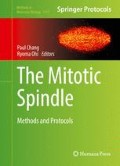Abstract
Microtubule dynamic instability, the process by which individual microtubules switch between phases of growth and shrinkage, is essential for establishing the architecture of cellular microtubule structures, such as the mitotic spindle. This switching process is regulated by a complex network of microtubule-associated proteins (MAPs), which modulate different aspects of microtubule dynamic behavior. To elucidate the effects of MAPs and their molecular mechanisms of action, in vitro reconstitution approaches with purified components are used. Here, I present methods for measuring individual and combined effects of MAPs on microtubule dynamics, using purified protein components and total-internal-reflection fluorescence (TIRF) microscopy. Particular focus is given to the experimental design, proper parameterization, and data analysis.
Access this chapter
Tax calculation will be finalised at checkout
Purchases are for personal use only
References
Mitchison TJ, Kirschner MW (1984) Dynamic instability of microtubule growth. Nature 312:237–242
Lyle K, Kumar P, Wittmann T (2009) SnapShot: microtubule regulators I. Cell 136:380–380.e1. doi:10.1016/j.cell.2009.01.010
Akhmanova A, Steinmetz MO (2008) Tracking the ends: a dynamic protein network controls the fate of microtubule tips. Nat Rev Mol Cell Biol 9:309–322. doi:10.1038/nrm2369
Howard J, Hyman AA (2007) Microtubule polymerases and depolymerases. Curr Opin Cell Biol 19:31–35. doi:10.1016/j.ceb.2006.12.009
Walker RA, O’Brien ET, Pryer NK et al (1988) Dynamic instability of individual microtubules analyzed by video light microscopy: rate constants and transition frequencies. J Cell Biol 107:1437–1448
Zanic M, Widlund PO, Hyman AA, Howard J (2013) Synergy between XMAP215 and EB1 increases microtubule growth rates to physiological levels. Nat Cell Biol 15(6):688–693. doi:10.1038/ncb2744
Wieczorek M, Chaaban S, Brouhard GJ (2013) Macromolecular crowding pushes catalyzed microtubule growth to near the theoretical limit. Cell Mol Bioeng. doi:10.1007/s12195-013-0292-9
Srayko M, Kaya A, Stamford J, Hyman AA (2005) Identification and characterization of factors required for microtubule growth and nucleation in the early C. elegans embryo. Dev Cell 9:223–236. doi:10.1016/j.devcel.2005.07.003
Gardner MK, Zanic M, Gell C et al (2011) Depolymerizing kinesins Kip3 and MCAK shape cellular microtubule architecture by differential control of catastrophe. Cell 147:1092–1103. doi:10.1016/j.cell.2011.10.037
Kerssemakers JWJ, Munteanu EL, Laan L et al (2006) Assembly dynamics of microtubules at molecular resolution. Nature 442:709–712. doi:10.1038/nature04928
Schek H, Gardner MK, Cheng J et al (2007) Microtubule assembly dynamics at the nanoscale. Curr Biol 17:1445–1455. doi:10.1016/j.cub.2007.07.011
Gardner MK, Charlebois BD, Jánosi IM et al (2011) Rapid microtubule self-assembly kinetics. Cell 146:582–592. doi:10.1016/j.cell.2011.06.053
Howard J, Hyman AA (2009) Growth, fluctuation and switching at microtubule plus ends. Nat Rev Mol Cell Biol 10:569–574. doi:10.1038/nrm2713
Verde F, Dogterom M, Stelzer E et al (1992) Control of microtubule dynamics and length by cyclin A- and cyclin B-dependent kinases in Xenopus egg extracts. J Cell Biol 118:1097–1108
Gell C, Bormuth V, Brouhard GJ et al (2010) Microtubule dynamics reconstituted in vitro and imaged by single-molecule fluorescence microscopy. Methods Cell Biol 95:221–245. doi:10.1016/S0091-679X(10)95013-9
Schindelin J, Arganda-Carreras I, Frise E et al (2012) Fiji: an open-source platform for biological-image analysis. Nat Methods 9:676–682. doi:10.1038/nmeth.2019
Abràmoff MD, Magalhães PJ (2004) Image processing with ImageJ. Biophotonics Int 11:36–42
Hyman AA, Salser S, Drechsel DN et al (1992) Role of GTP hydrolysis in microtubule dynamics: information from a slowly hydrolyzable analogue, GMPCPP. Mol Biol Cell 3:1155–1167
Ashford AJ, Andersen S, Hyman AA (1998) Preparation of tubulin from bovine brain. In: Celis J (ed) Cell biology: a laboratory handbook. Academic Press, New York
Gell C, Friel CT, Borgonovo B et al (2011) Purification of tubulin from porcine brain. Methods Mol Biol 777:15–28. doi:10.1007/978-1-61779-252-6_2
Castoldi M, Popov AV (2003) Purification of brain tubulin through two cycles of polymerization–depolymerization in a high-molarity buffer. Protein Expr Purif 32:83–88. doi:10.1016/s1046-5928(03)00218-3
Hyman AA, Drechsel DN, Kellogg D et al (1991) Preparation of modified tubulins. Meth Enzymol 196:478–485
Widlund PO, Podolski M, Reber SB et al (2012) One-step purification of assembly-competent tubulin from diverse eukaryotic sources. Mol Biol Cell 23:4393–4401. doi:10.1091/mbc.E12-06-0444
Fygenson D, Braun E, Libchaber A (1994) Phase diagram of microtubules. Phys Rev E 50:1579–1588
Acknowledgements
I thank Anika Rahman for help with the data analysis. I am grateful to Justin Bois, Gary Brouhard, Melissa Gardner, Anneke Hibbel, Jonathon Howard, Elizabeth Lawrence, Chloe Snider, Michal Wieczorek, and especially Marija Podolski for helpful discussions and comments on the manuscript.
Author information
Authors and Affiliations
Corresponding author
Editor information
Editors and Affiliations
Rights and permissions
Copyright information
© 2016 Springer Science+Business Media New York
About this protocol
Cite this protocol
Zanic, M. (2016). Measuring the Effects of Microtubule-Associated Proteins on Microtubule Dynamics In Vitro. In: Chang, P., Ohi, R. (eds) The Mitotic Spindle. Methods in Molecular Biology, vol 1413. Humana Press, New York, NY. https://doi.org/10.1007/978-1-4939-3542-0_4
Download citation
DOI: https://doi.org/10.1007/978-1-4939-3542-0_4
Published:
Publisher Name: Humana Press, New York, NY
Print ISBN: 978-1-4939-3540-6
Online ISBN: 978-1-4939-3542-0
eBook Packages: Springer Protocols

